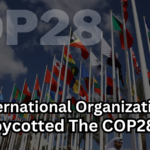One of the inquiries that may be of interest pertains to the agenda of COP28. Numerous actionable steps are expected to be witnessed, including reducing greenhouse gasses through implementing novel technologies and strategies, amongst others. This guide aims to provide comprehensive information regarding the COP28 meeting agenda and its planning process. Without further ado, let us commence our discussion to address COP28 agenda development.
COP28 Agenda & Objectives
A diverse range of COP28 issues are said to be on the table for discussion as part of the ongoing efforts to address the global climate crisis:
- Operationalizing Loss & Damage Fund
- Ocean Advocacy
- Climate Adaptation Funding Framework
- Global Adaptation Framework Approval
- JETP’s Successful Green Transitions
- Global Early Warning System
- Global Stocktake Progress
- Food And Climate Action
Let’s discuss each of them in details:
1. Operationalizing Loss & Damage Fund
During the 27th Conference of Parties (COP), a transitional committee was established for the Loss and Damage Agreement. This committee is tasked with proposing ways to implement the fund, and its first meeting is scheduled in March leading up to COP 28. Unnikrishnan Divakaran Nair, the Head of the Climate Change Department, has emphasized the importance of paying close attention to the proper collection and use of funds.
2. Ocean Advocacy
COP 28 will feature a discussion on the significance of the ocean and its aquatic inhabitants. Including the sea level rise, how to mitigate the impending threat and a collective framework to devise plan of action to propagate ocean advocacy.
3. Climate Adaptation Funding Framework
High-income countries have not achieved the COP 15 conference’s target of providing $100 billion for adaptation funding. The current climate crisis has resulted in daily losses of approximately $200. The upcoming COP 28 conference is said to establish a framework to meet the global adaptation goal. This framework will benefit farmers whose livelihoods are directly impacted by the climate.
4. Global Adaptation Framework Approval
The Paris Agreement created the Global Goal of Adaptation. COP 27 designed a framework for it. The framework will be talked about before COP 28. It needs approval in November at the convention.
5. JETP’s Successful Green Transitions
Up to this point, JETPs (Just Energy Transition Partnership) has aided nations such as South Africa (COP 26), Indonesia, and Vietnam (previous year) in utilizing combined funding to break away from coal reliance and shift towards a greener energy combination.
6. Global Early Warning System
Plan launched at COP27 by U.N.Secretary General enables a multi-hazard early warning system to cover all inhabitants of the planet within the next five years. However, in 2023 three things will be on priority:
- Recognizing gaps and assessing people’s ability to manage the early warning system
- Proceeding with the execution of the system after analyzing its capabilities
- Ensuring that there is an increase in funding to support the system
Guterres will update on the progress made during COP 28.
7. Global Stocktake Progress
The Global Stocktake, a critical component of the Conference of Parties (COP), is set to conclude at the 28th session of the conference. This biennial process occurs every five years and is presently in its second stage, featuring a technical evaluation phase.
During this phase, through face-to-face deliberations, experts engage in in-depth discussions concerning the three core themes of mitigation, adaptation, and implementation/support. The outputs of these discussions will be presented and thoroughly examined at the upcoming COP 28 summit.
8. Food And Climate Action
During COP27, a new food plan was created. The sole issue was the exclusion of the food systems strategy in the ultimate agreement. Crucial factors such as nourishment, dietary changes, and plans for adaptation and mitigation were disregarded. The program agenda of the food and land use Coalition aims to improve results at the Global Stocktake and COP 28 through advocacy.
To keep the temperature rise below 1.5°C, the Food and Agriculture Organization has a plan to lower emissions from food and agriculture. The Agriculture Innovation Mission (AIM) for Climate will host a summit in Washington, D.C. The United States and the United Arab Emirates (UAE) lead the initiative, while the United Nations (UN) serves as a founding member. The goal is to raise the funding for climate-smart agriculture innovation from $8 billion to $10 billion by COP 28.






